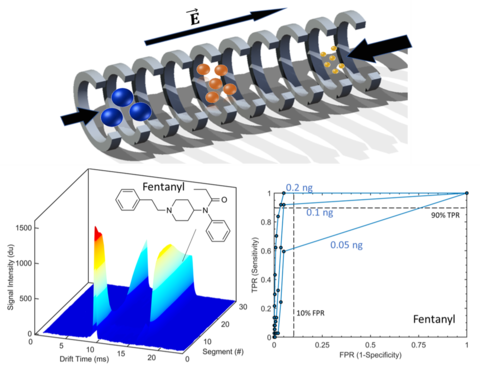Summary
Ion mobility spectrometry (IMS) is widely used for national security and law enforcement, placed at key transportation checkpoints such as airports and border crossings for the trace detection of drugs and explosives. Its simplicity, ease of operation, portability, and rapid analytical performance provides a basis for its real-time screening capability.
Description
IMS employs a drift tube with an applied electric field to separate ionized molecules based on their mobility. The technique is robust and capable of differentiating a wide range of drug and explosive molecules. Recent work has sought to investigate the utility of IMS for screening of illicit narcotics , specifically fentanyl and fentanyl analogues, for interdiction at border crossings and postal facilities. A receiver operating characteristic (ROC) curve approach demonstrated the relationship between sensitivity and specificity of the technology to detect fentanyl-related species against environmental background. Baseline environmental background levels were evaluated from over 10,000 screening samples from vehicles entering a federal facility. The framework demonstrates the importance of characterizing environmental background for each target screening arena.

Related work has developed methodology for evaluating trace detection technology, specifically IMS, to combat the illicit transportation and trade of fentanyl and fentanyl-related substances. A suite of commercial IMS instruments were employed in the development of a method that included 11 fentanyl-related species, 3 additives, and 8 false positive compounds. The target fentanyl-related species were derived from a compilation of the most frequently seized materials in the U.S. since 2015. Similarly, the three confusant additives (heroin, procaine, and quinine) were included based on commonly encountered drug mixtures. Finally, an additional eight authentic pharmaceuticals and common illicit drugs were included to characterize discrimination of false positives. The proposed method enables preliminary validation for the detection of these species to aid in instrument algorithm development.


